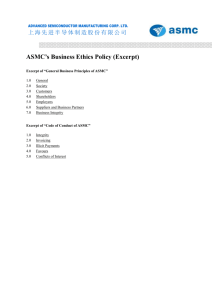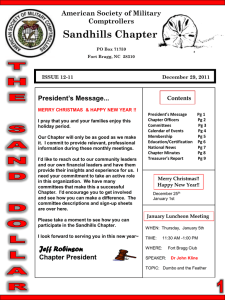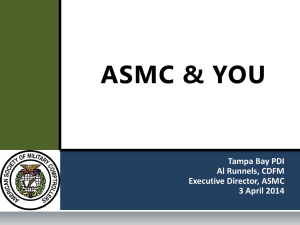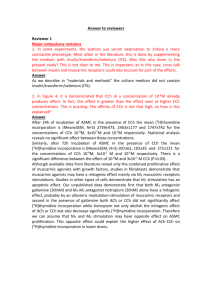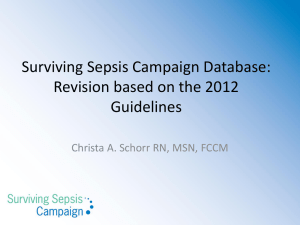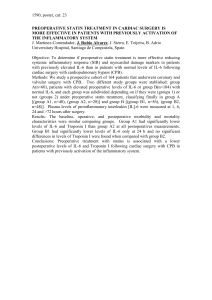cea12421-sup-0001-Datas1
advertisement
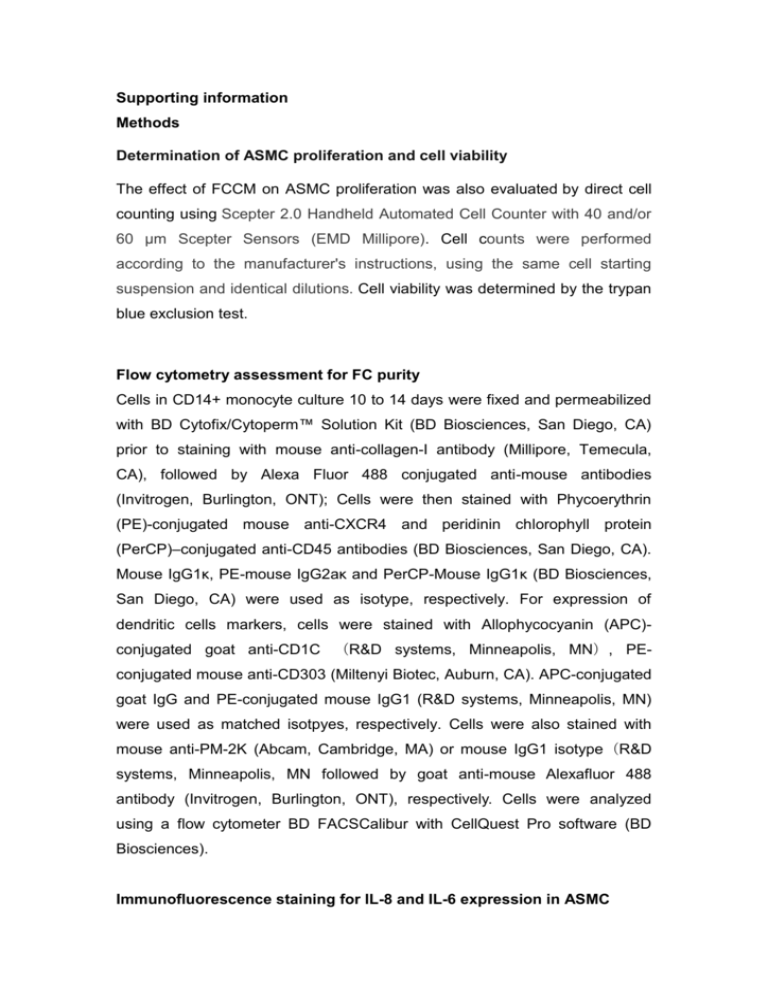
Supporting information Methods Determination of ASMC proliferation and cell viability The effect of FCCM on ASMC proliferation was also evaluated by direct cell counting using Scepter 2.0 Handheld Automated Cell Counter with 40 and/or 60 μm Scepter Sensors (EMD Millipore). Cell counts were performed according to the manufacturer's instructions, using the same cell starting suspension and identical dilutions. Cell viability was determined by the trypan blue exclusion test. Flow cytometry assessment for FC purity Cells in CD14+ monocyte culture 10 to 14 days were fixed and permeabilized with BD Cytofix/Cytoperm™ Solution Kit (BD Biosciences, San Diego, CA) prior to staining with mouse anti-collagen-I antibody (Millipore, Temecula, CA), followed by Alexa Fluor 488 conjugated anti-mouse antibodies (Invitrogen, Burlington, ONT); Cells were then stained with Phycoerythrin (PE)-conjugated mouse anti-CXCR4 and peridinin chlorophyll protein (PerCP)–conjugated anti-CD45 antibodies (BD Biosciences, San Diego, CA). Mouse IgG1κ, PE-mouse IgG2aκ and PerCP-Mouse IgG1κ (BD Biosciences, San Diego, CA) were used as isotype, respectively. For expression of dendritic cells markers, cells were stained with Allophycocyanin (APC)conjugated goat anti-CD1C (R&D systems, Minneapolis, MN), PEconjugated mouse anti-CD303 (Miltenyi Biotec, Auburn, CA). APC-conjugated goat IgG and PE-conjugated mouse IgG1 (R&D systems, Minneapolis, MN) were used as matched isotpyes, respectively. Cells were also stained with mouse anti-PM-2K (Abcam, Cambridge, MA) or mouse IgG1 isotype(R&D systems, Minneapolis, MN followed by goat anti-mouse Alexafluor 488 antibody (Invitrogen, Burlington, ONT), respectively. Cells were analyzed using a flow cytometer BD FACSCalibur with CellQuest Pro software (BD Biosciences). Immunofluorescence staining for IL-8 and IL-6 expression in ASMC After overnight starvation, 1x104 ASMC and 5x103 FC were cultured in one well of a 8-chamber culture slide (BD Biosciences, Bedford, MA) for 48 hours. Golgistop (BD Biosciences, San Diego, CA) was added 4 hours before staining and cells were then washed with PBS and fixed with 4% paraformaldehyde and permeabilized with 0.1% Tween 20 in PBS (PBST). Cells were blocked with 1% BSA in PBST and stained with mouse anti-IL-8 (R&D systems, Minneapolis, MN) or rabbit anti-IL-6 (Abcam, Cambridge, MA) antibody followed by goat anti-mouse or donkey anti-rabbit Alexafluor 555 antibody (Invitrogen, Burlington, ONT), respectively. Diluent without primary antibodies was used as control. After washing with PBST, cell nucleus was stained with Hoechest 33342 (AnaSpec, Fremont, CA), mounted with PermaFluor (Thermo scientific, Fremont, CA). Cells were viewed with an Olympus BX-51 microscope (Olympus Optical Co., Melville, NY) equipped with reflected ultraviolet light illumination. Short-interference RNA (siRNA) ASMC were plated in 6-well plates and grown to 70–80% confluency in medium containing 10% FBS. Cells were then transfected with siRNA targeting NF-κB p65 (Santa Cruz Biotechnology, Santa Cruz, CA) or ERK1/2 (Cell Signaling, Danvers, MA) using the siRNA Reagent System (Santa Cruz Biotechnology, Santa Cruz, CA). The scramble siRNA (Santa Cruz Biotechnology) was used as a negative control. After overnight starvation, ASMC were transferred to the lower well of transwell plate and cultured with FC in the upper well with cell number ratio 2:1 in stavation medium for 48 hours. Supernatant was collected for ELISA of IL-8 and IL-6, while protein lysates of ASMC were harvested to examine gene knockdown efficiency by western blotting. Western blot analysis Assessment of knockdown efficiency: ASMC post knockdown in transwell culture with FC for 48 hours were washed twice with cold PBS and lysed. Whole-cell lysate was loaded onto a 10% acrylamide SDS-PAGE NEXT GEL (Amresco, Solon, Ohio), followed by transfer to nitrocellulose membranes (Bio-Rad Laboratories, Hercules, Calif). The blots were then blocked for 1 hour at room temperature and incubated overnight at 4°C with antibodies specific for rabbit anti-NFκB (Santa Cruz Biotechnology) and mouse antiGAPDH (Millipore). After washing (0.1% Tween-20/PBS), membranes were incubated with IRDye 680 goat anti-mouse IgG and IRDye 800 goat antirabbit IgG (Rockland, Philadelphia, PA) and analyzed with an Odyssey IR scanner by using Odyssey imaging software 3.0 (LI-COR Biosciences). Membranes were then reprobed with rabbit anti–total ERK1/2 (Cell Signaling) and IRDye 680 goat anti-rabbit IgG (Rockland, Philadelphia, Pa). Assessment of α-smooth muscle actin (α-SMA) and myosin light chain kinase (MLCK): ASMC in transwell culture with FC for 48 hours were washed twice with cold PBS and lysed. Whole-cell lysate was loaded onto a 10% acrylamide SDS-PAGE NEXT GEL (Amresco, Solon, Ohio), followed by transfer to nitrocellulose membranes (Bio-Rad Laboratories, Hercules, Calif). The blots were then blocked for 1 hour at room temperature and incubated overnight at 4°C with antibodies specific for rabbit anti-MLCK (Abcam) and mouse anti-α-SMA (R&D Systems, MN, USA). After washing (0.1% Tween20/PBS), membranes were incubated with IRDye 680 goat anti-mouse IgG and IRDye 680 goat anti-rabbit IgG (Rockland, Philadelphia, Pa) and analyzed with an Odyssey IR scanner by using Odyssey imaging software 3.0 (LI-COR Biosciences). The membranes were then reprobed with mouse antiGAPDH (Millipore) and IRDye 680 goat anti-mouse IgG (Rockland, Philadelphia, Pa). Supplement figure legends Figure S1. Airway smooth muscle cells (ASMC) and Carboxyfluorescein Diacetate Succinimidyl Ester (CFSE)-labeled (5 μM) fibrocytes (FC) were cultured separately for 48 hours. CFSE expression was tested by flow cytometry. Histograms of CFSE expression of ASMC (upper panel) and CFSE-labeled FC (lower panel) revealed no overlap of ASMC and FC by CSFE expression. Figure S2. Purified FC do not express markers of myeloid dendritic cells (CD1C), plasmacytoid dendritic cells (CD303) or macrophage (PM-2K). Purified FC after culture 10 to 14 days were accessed the expression of (A) CD1C and (B) CD303 (C) PM-2K by flow cytometry. Histograms of matched isotypes (upper panels) and CD1C/CD303/PM-2K staining FC (lower panels) revealed no expression of these markers in FC. Figure S3. Thymidine incorporation and cell number of ASMC treated with Fibrocytes (FC) conditioned medium (FCCM). ASMC were treated for 48 hours with FCCM at various concentration (0, 25, 50 or 100%). 24 hours prior harvesting onto glass fiber filters (Wallac), cells were labeled with 5 µCi/well of 3H-methyl thymidine and thymidine incorporation was then quantified. ASMC were also deteached and cell number was couned. Figure S4. Fibrocytes (FC) conditioned medium (FCCM) or co-culture with FC did not affect Ki-67 expression of airway smooth muscle cells (ASMC). (A) and (B): FC were starved for 48 hours and FCCM was harvested and mixed with starvation medium in the ratio of 1:4 or 1:2. PDGF treatment (10 ng/ml) was used as positive control. (A) Example of Ki-67 expression in ASMC postPDGF treatment accessed by flow cytometry. ASMC stained with isotype (upper histogram) and anti-Ki-67-PE (lower histogram). Positive expression of Ki-67 was defined by isotype. (B) Ki-67 expression in ASMC incubated with FCCM from asthmatic or normal subjects (n=3~5, each experiment had equal subject numbers between groups). (C) and (D): Ki-67 expression in ASMC after 48 hours co-culture with CFSE-labeled FC in the ratio of cell number 2:1 (ASMC:FC), 4:1 or ASMC alone at the same cell density in the lower well. (C) ASMC and CFSE-labeled FC were distinguished by CFSE expression. Ki-67 expression in ASMC was analyzed from CFSE negative population. (D) Ki-67 expression in ASMC alone or ASMC co-cultured with FC from asthmatic or normal subjects. AS: asthmatic; NS: normal subject (n=3). Figure S5. Collagen-I expression of airway smooth muscle cells (ASMC) after 48 hours co-culture with fibrocytes (FC) in the ratio of cell number 2:1 (ASMC:FC), 4:1 or ASMC alone. Collagen-I of ASMC was tested by flow cytometry. (A) Co-culture of NSASMC+NSFC. (B) Co-culture of ASASMC+ASFC. AS: asthmatic; NS: normal subject. (n=3) Figure S6. Levels of total TGF-β and eotaxin in the supernatant from fibrocytes (FC), airway smooth muscle cells (ASMC), co-culture of ASMC and FC in the ratio of cell number 4:1 (ASMC:FC) and 2:1. Cells were cultured at a density of 4.68x104/cm2 for 48 hours and cytokines levels of supernatant were detected by ELISA. (A and B) Level of total TGF-β and eotaxin (C and D) in the co-culture of NSASMC+NSFC and ASASMC+ASFC. Level of active TGFbeta in all experiments was below the detection limit of ELISA kit. AS: asthmatic; NS: normal subject. (n=3). Figure S7. Effect of fibrocyte conditioned medium (FCCM) on IL-8 and IL-6 production by airway smooth muscle cells (ASMC). ASMC were treated with conditioned medium collected from fibrocytes (FCCM) or starving medium and ELISA of IL-8 and IL-6 of FCCM or in the supernatant was performed after 48 hours culture with starving medium (ASMC) or FCCM (FCCM+ASMC)(n=3). Figure S8. ASMC produce IL-8 and IL-6 after treatment of fibrocytes conditioned medium (FCCM). FC were starved for 48 hours and FCCM harvested. ASMC were cultured in the chamber slide with FCCM or starving medium for 48 hours. Production of IL-8 and IL-6 of ASMC was assessed by immunofluorescence staining. (A) Anti-human IL-8 and (B) IL-6 antibody followed by 2nd antibody of Alexa Fluor 555 (red) and Hoechst 33342 for nuclei (blue) were stained on ASMC that were treated with FCCM (FCCM+) or medium only (FCCM-). Composite images revealed higher expression of IL-8 and IL-6 on ASMC treated with FCCM than ASMC in medium only. Figure S9. Levels of IL-8 and IL-6 in the supernatant from transwell of (A) NSASMC+NSFC, (B) ASASMC+ASFC and (C) NSASMC+ASFC. P65 and ERK1/2 of ASMC were knocked down by siRNA before transwell experiment. ASMC in lower well and fibrocytes (FC) in upper well were cultured in the ratio of cell number 2:1. IL-8 and IL-6 levels of supernatant after 48 hours transwell culture were detected by ELISA. *<0.05 by unpaired t-test. (n=3~5)
